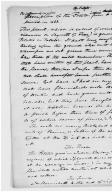[ The Potato ] William Paine
Date: This recipe is from Reel 1 of William Paine's Papers, correspondence dated 1768-1822. | 1768/01/01 to 1822/12/31
Source:
William Paine Papers
Institution: University Of New Brunswick
| Source Origin: Loyalist Collection
| Reference: MIC-Loyalist FC LFR.P3W5P3
This recipe includes physical descriptions of the potato plant, as well as preparation suggestions. Reel 1. Image use courtesy of American Antiquarian Society.
The Potato
The following curious the following curious
Description of the Potato is copied from a History of Plants
printed in 1633.
This plant (which is called of some, Sisarum Peru –
vianum, or Skyrrets of Peru) is generally of us called
Potatus or Potato’s. It hath long rough flexible branches
trailing upon the ground like unto those of Pompions,
whereupon are set greene three cornered leaves, very
like those of the wild cucumber. There is not any
that have written of this plant, have said anything of
the flowers; therefore I rifer this assumption unto those
that shall hereafter have further knowledge of the
same. Yet have I had in my garden divers roots
that have flourished unto the first approach
of Winter, and have grown unto a great length of
branches, but they have brought forth no flowers,
at all; Whether because the winter causeth them
to perish before their time of flowering, or that they
be of nature barren of flowers, I am not certain.
The roots are many, thicke, and knobly, like unto the
roots of Peonies, or rather of the white Asphodile, joined
together at the top into one head in manner of the Skye-
root.
The Place
The Potato’s grow in India, Barbary, Spain, and other hot
regions; of which I planted divers roots, (which I bought
at the exchange in London) in my garden, where they
flourished untill winter, at which time they perished
and rotted.
The Time
It flourisheth to the end of September. At the
first approach of great frosts the leaves together with
the roots and stalks do perish.
The Names.
Clusius calleth it Batata, Camotes, Amates, and Ignames:
in English, Potatoes, Potatus, and Potades.
The Nature
The leaves of Potato’s are hot and dry, or may evidently
appeare by the taste: the roots are of a temperate qualities.
The Vertues
The Potato roots are among the Spaniards, Italians, Indians,
and many other nations, ordinarie and common meat;
which no doubt are of mighty and nourishing parts, and
doe strengthen and comfort nature; whose nutriment
is as it were a mean between flesh and fruit, but
somewhat windie; yet being rested in the embers they
lose much of their windinesse, especially being eaten
sopped in wine.
Of those roots may be made conserves no less
toothsome, wholsome and dainty than of the flesh
of quinces, and likewise those comfortable and
delicate meats called in shops. Morselli Placentulae
and diuers other such like.
These roots may serve as a ground or foundation
whereon the cunning Confectioner
frame many comfortable and delicate conserves,
and
They are used to be eaten rosted in the ashes.
Some when they be so rosted infuse them and sop them
in wine – and others, to give them the greater grace in
eating, do boyle them with prunes, and so eat them.
Likewise others dress them with oil, vinegar, and salt/every
man according to his own taste and liking.
Download: Transcription | Images


